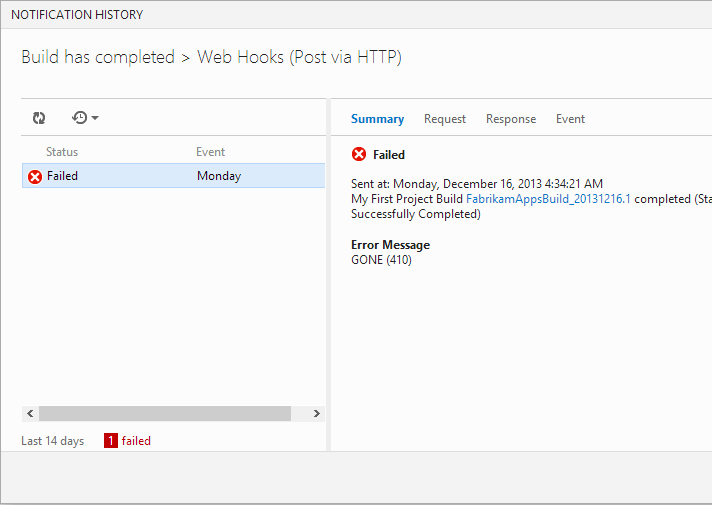Note
Access to this page requires authorization. You can try signing in or changing directories.
Access to this page requires authorization. You can try changing directories.
Azure DevOps Services | Azure DevOps Server 2022 | Azure DevOps Server 2020
This article offers general troubleshooting guidance for Azure DevOps service hooks. It also provides answers to frequently asked questions (FAQs).
View activity and debug problems
The Service Hooks page in the web access admin summarizes activity from the last seven days for each subscription. The page also shows whether each subscription is enabled, disabled, or restricted.
For each subscription, you can access a detailed history that includes the complete request and response data for each event. This information can help you debug a problematic service or subscription.
To view the activity and status of your subscriptions, go to the Service Hooks page.
To view detailed activity for a subscription, including full request, response, and event payload data, select a subscription in the table, and then select History.
Subscription failures and probation (restricted)
If the HTTP response to a notification request indicates an error, the severity of the failure determines how Azure DevOps responds. Certain types of failures can disable subscriptions or put them on probation.
Failure types
Failures from service hook notifications are grouped into the following categories:
- Terminal failures
- Transient failures
- Enduring failures
The error code from the HTTP response determines how Azure DevOps categorizes the failure.
Terminal failures
The only HTTP status code that's categorized as a terminal failure is 410 (Gone).
When a terminal failure occurs in a subscription, the subscription is automatically disabled no matter its prior state.
Transient failures
HTTP responses with the following status codes are categorized as transient failures:
- 408 (Request Timeout)
- 502 (Bad Gateway)
- 503 (Service Unavailable)
- 504 (Gateway Timeout)
When a transient failure occurs in a subscription, Azure DevOps attempts to resend the notification up to eight times, with an increasing delay between each attempt.
The following table lists information about retries that are attempted after a transient failure occurs. Included is the approximate backoff time, or the time to wait before attempting to resend a notification. The maximum backoff time is 60 seconds. The table also shows the total delay for each retry.
| Retry number | Backoff time in seconds | Total delay in seconds |
|---|---|---|
| 1 | 1 | 1 |
| 2 | 2 | 3 |
| 3 | 4 | 7 |
| 4 | 8 | 15 |
| 5 | 16 | 31 |
| 6 | 32 | 63 |
| 7 | 60 | 123 |
| 8 | 60 | 183 |
If all retries for a notification are exhausted and each attempt results in a transient failure, the notification is no longer sent. Instead, it's categorized as an enduring failure.
Enduring failures
All other HTTP failure codes, for example, 404 (Not Found) and 500 (Internal Server Error), result in enduring failures.
When an enduring failure occurs in a subscription, the subscription is placed on probation.
Probation
When a subscription is on probation, any new events are lost. The system makes a limited number of attempts to resend the failed notification.
The following table lists approximate backoff times and total probation times for retries that are attempted during probation. At most seven retries are attempted, and the maximum backoff time for a probation retry is 15 hours.
| Retry number | Backoff time | Total probation time in hours |
|---|---|---|
| 1 | 20 minutes | 0.33 |
| 2 | 40 minutes | 1 |
| 3 | 1 hour 20 minutes | 2.33 |
| 4 | 2 hours 40 minutes | 5 |
| 5 | 5 hours 20 minutes | 10.33 |
| 6 | 10 hours 40 minutes | 21 |
| 7 | 15 hours | 36 |
If the subscription receives a successful response while on probation, it gets restored to a fully enabled state, and events are published again. If all seven retries fail, the subscription state gets set to DisabledBySystem.
FAQs
Q: What is the payload limit of a service hook?
A: The payload limit is 2 MB. Larger payloads cause degradation in performance and reliability. As a best practice, service hooks should limit the payload to 2 MB.
Q: What does the state Enabled (restricted) mean?
A: A subscription becomes restricted if too many failures occur. Being in the Enabled (restricted) state is the same as being on probation.
Q: What does the state Disabled (due to failures) mean?
A: A subscription is automatically disabled in the following cases:
- A terminal failure is encountered.
- A series of consecutive failures occurs over a prolonged period.
Notifications that result in transient failures are retried several times before being declared enduring failures. Enduring failure notifications are retried a limited number of times during probation. If all probation retries fail, the subscription gets disabled.
The following status codes provide examples of each type of failure:
- Transient: 408 (Request Timeout), 502 (Bad Gateway), 503 (Service Unavailable), 504 (Gateway Timeout)
- Terminal: 410 (Gone)
- Enduring: All failures that aren't transient or terminal
Q: What does the state Disabled (user left project) mean?
A: The user who created the subscription is no longer a member of the team.
Q: What should I try if a service hook isn't working?
A: Check the following items:
- Confirm the subscription is enabled.
- Confirm the subscription settings are correct. Check event filters and actions.
- Look at the history, especially if there are failures.
Q: Can I grant a regular project user the ability to view and manage service hook subscriptions for a project?
A: By default, only project administrators have these permissions. To grant them to other users directly, you can use the command-line tool or the Security REST API.
Q: Can I programmatically create subscriptions?
A: Yes, use REST APIs.

